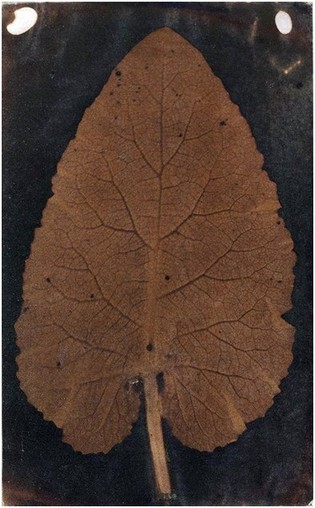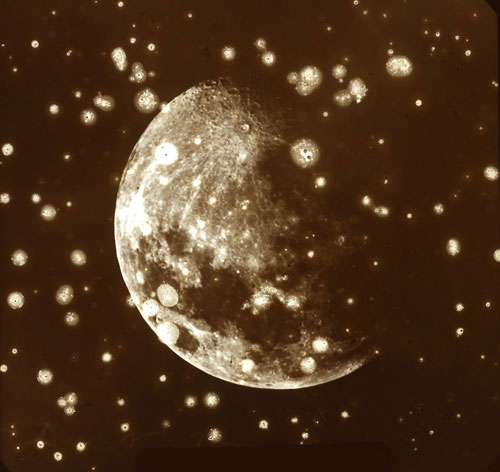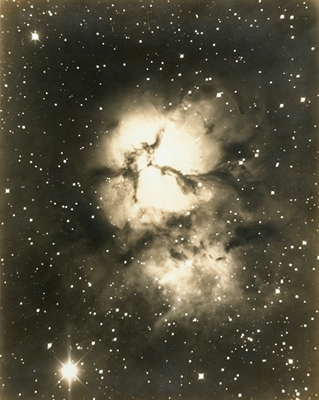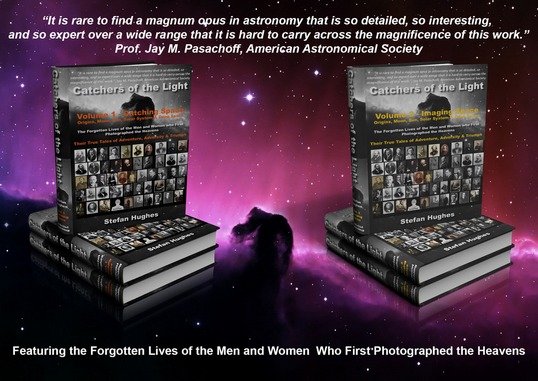 'Photogram' of a Leaf attributed to Thomas Wedgwood, c1800
'Photogram' of a Leaf attributed to Thomas Wedgwood, c1800
Firstlight
“In 1851 Scott Archer and Dr. Diamond introduced the collodion process in practical form, and this finally prepared the way for such a worker as Mr. De La Rue; for the introduction of the collodion process was an event in photography second only in importance to the discovery by Daguerre in 1839.”
Lady Margaret Lindsay Murray Huggins (1848-1915).
Daguerreotype v Calotype
The earliest origins of Astrophotography are intrinsically linked to the development of the photographic process as introduced by Louis Daguerre (1787-1851) in 1839; for it was with his Daguerreotype method that the first successful photographs of astronomical objects were obtained during the 1840s and early 1850s.
The other early photographic process, the Calotype of William Henry Fox Talbot (1800-1877) was little used in astronomical photography, partly because of the patent restrictions placed on its application, but mainly due to its lack of sensitivity when compared to its competitor the Daguerreotype.
Wet Collodion
However by the mid 1850s onwards both had been replaced by newer and more light sensitive chemically based photographic processes. In 1851 the sculptor and chemist, Frederick Scott Archer (1814-1857) published his ‘wet collodion’ method; its introduction marked a major step forward in the development of photography. Not only was it more sensitive than processes of Daguerre and Fox Talbot, it also incorporated the advantages each had over the other.
Wet collodion photographs possessed the same fine detail as exhibited by the Daguerreotype; and like the Calotype multiple positive copies could be obtained from a negative image. The method was not perfect and required a certain amount of chemical aptitude in the use of several potentially dangerous substances including Potassium Cyanide and Bi-chloride of Mercury. In addition wet collodion plates had to be developed within 15 minutes or so after exposure before the collodion solution dried and therefore required the use of a portable darkroom when taking images ‘in the field’.
The ‘wet collodion’ process became widely used in astronomical photography from 1851 onwards, a number of pioneers used it to take images of the sun, moon, planets and stars. George Philips Bond, John Adams Whipple and James Wallace Black used it to in 1857, obtain images of stars as faint as the sixth magnitude. In 1858, William Usherwood, a miniature artist from Walton-on-the-Hill. Surrey, England, used the wet collodion method to take the first successful image of a Comet on the 27th of September that year, when he imaged Comet Donati.

Collodion Photograph of the Moon by Neville Story Maskelyne, 1857
Dry Collodion
In 1864 the Collodio-Bromide process was published by William Blanchard Bolton (1848-1899) and Benjamin Jones Sayce (1837-1895). In their ‘dry collodion’ process a ready-made emulsion of Collodion and Silver Bromide was poured directly onto the glass plate The prepared plates can be kept for some time before deterioration sets. It was unfortunately less light sensitive than the wet collodion process and was never used in astronomical photography.
Gelatino-Bromide
In 1871 by Richard Leach Maddox’s (1816-1902) proposed the use of the Gelatino-Bromide ‘dry’ photographic plate. It was this process which marked the greatest advance in the development of astronomical photography, even more so than the introduction of Archer’s wet collodion method. The increased sensitivity of the ‘dry’ plate over Archer’s ‘wet’ process enabled the first images of Deep Space Objects (DSOs), so called because they are only found in the deep recesses of the universe, far beyond the confines of our own insignificant Solar System.
The ‘dry’ plate technology was only slowly accepted by both astronomers and photographers in general. It was not until the introduction of ‘mass produced’ dry plates from 1877 onwards that the gelatino-bromide method began to replace the collodion processes.
Only in 1880 did the New York Doctor, Henry Draper with the aid of a ‘dry’ photographic plate obtain the first image of a DSO - when he imaged the ‘Great Orion’ nebula (M42) on the 30th of September that year.
Celluloid Film
The coming decades saw the development of photographic emulsions sensitive to all parts of the visible spectrum and beyond; for both glass plates and the celluloid film (following its introduction in 1889).
In 1906 Charles Edward Kenneth Mees, when working for Wratten & Wainwright, produced the very first true panchromatic photographic plate, i.e. sensitive to all colours including ‘deep red’.
Following Mees’ move to KODAK in 1907 to head their research laboratory at Rochester, New York, the company introduced a range of photographic emulsions particularly suited for astronomical use, most notably the KODAK 103a series and latterly the black and white Tech Pan and the colour Ektachrome films.
CCD
In 1969 came the greatest technological leap (so far) in astronomical photography with the invention of the Charge Coupled Device or CCD, by Willard Sterling Boyle and George Elwood Smith. Although originally designed for use as a form of solid state memory device, its application as an imaging device was developed by others and in particular Michael Francis Tompsett, who filed the first CCD imaging patent in 1971.
The digital imaging cameras developed in the 1970s and 1980s by the likes of Fairchild Imaging and KODAK were introduced into astronomy in 1979 at the Kitt Peak Observatory in Arizona. The first useable and affordable CCD cameras for the amateur astronomer were introduced in the 1990s by firms such as Celestron and the Santa Barbara Imaging Group.
The modern CCD camera and the introduction of fast Personal Computers, when coupled with the availability of high quality optical telescopes has revolutionized amateur Astrophotography during the last decade or so.
Quote
“It is somewhat difficult to lay down any precise instructions for the successful development of astronomical photographs. Much might be written, and pages of various formula; given; but after all, experience, and extreme, almost antiseptic, cleanliness are the chief aids to success; and those readers who have successfully followed the methods of ordinary photography are not likely to make many mistakes. It must be borne in mind that our object in Astrophotography is to produce negatives of extreme sharpness and accuracy of detail, and any method which would tend to produce the slighest effect which has no objective existence must be carefully avoided.”
Henry Hayden Waters (1880-1939), from Astronomical Photography for Amateurs, 1921.
To read more go to the eBook on the Origins of Astrophotography or buy the complete eBook 'Catchers of the Light' - A History of Astrophotography.

'Trifid' Nebula (M20) in Sagittarius, Goerge W. Ritchey, 1910

Buy the eBook or Printed Book at the 'Catchers of the Light' shop.